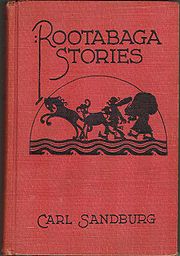
Rootabaga Stories
Encyclopedia

Carl Sandburg
Carl Sandburg was an American writer and editor, best known for his poetry. He won three Pulitzer Prizes, two for his poetry and another for a biography of Abraham Lincoln. H. L. Mencken called Carl Sandburg "indubitably an American in every pulse-beat."-Biography:Sandburg was born in Galesburg,...
. The whimsical, sometimes melancholy stories, which often use nonsense language, were originally created for his own daughters. Sandburg had three daughters, Margaret, Janet and Helga, whom he nicknamed "Spink", "Skabootch" and "Swipes" -those nicknames occur in some of his Rootabaga
Rutabaga
The rutabaga, swede , turnip or yellow turnip is a root vegetable that originated as a cross between the cabbage and the turnip; see Triangle of U...
stories. The "Rootabaga" stories were born of Sandburg's desire for "American fairy tales" to match American childhood. He felt that the European stories involving royalty and knights were inappropriate, and so set his stories in a fictionalized American Midwest
Midwestern United States
The Midwestern United States is one of the four U.S. geographic regions defined by the United States Census Bureau, providing an official definition of the American Midwest....
called "the Rootabaga country" filled with farms, trains, and corn fairies. A large number of the stories are told by the Potato Face Blind Man, an old minstrel of the Village of Liver-and-Onions who hangs out in front of the local post office. His impossibly acquired firsthand knowledge of the stories adds to the book's narrative feel and fantastical nature. In the Preface of the little known Potato Face, Sandburg wrote,
"it is in Rootabaga Country, and in the biggest village of that country, the Potato Face Blind Man sits with his accordion on the corner nearest the post office. There he sits with his eyes never looking out and always searching in. And sometimes he finds in himself the whole human procession.
Sandburg went on about the storyteller,'In fact, he sometimes indicates that when he needs an animal or fool not yet seen or heard of, he can make it for himself and give it a character so it is real to him, and when he talks about it and tells its story, it is like telling about one of his own children. He seems to love some of the precious things that are cheap, such as stars, the wind, pleasant words, time to be lazy, and fools having personality and distinction. He knows, it seems, that young people are young no matter how many years they live; that there are children born old and brought up to be full of fear; that a young heart keeps young by a certain measure of fooling as the years go by; that men and women old in years sometimes keep a fresh child heart and, to the last, salute the dawn and the morning with a mixture of reverence and laughter.
Sequels

Paul O. Zelinsky
Paul O. Zelinsky is an American author and illustrator of children's books. He was awarded the Caldecott Medal in 1998 for his Rapunzel. The best-selling movable book The Wheels on the Bus is his most popular work.-Early life:...
.
Recordings
- TC 1089
- A vinyl LPGramophone recordA gramophone record, commonly known as a phonograph record , vinyl record , or colloquially, a record, is an analog sound storage medium consisting of a flat disc with an inscribed, modulated spiral groove...
of Carl Sandburg reading some of the stories, Rootabaga Stories as told by Carl Sandburg was released on CaedmonCaedmon AudioHarperCollins Audio is a record label that specializes in audio books and other literary content. Formerly Caedmon Records, the name was changed when the label switched to CD-only production. Its marketing tag-line was Caedmon: a Third Dimension for the Printed Page.Caedmon was formed in 1953 by...
(TC 1089) in 1958; the cassette version is Caedmon CDL 51089. - Description: 2s. : 33 rpm, monaural. ; 12in.
- Read by the author.
- CONTENTS. - How they broke away to go to the Rootabaga country.-How they bring back the village of cream puffs.-How the five rusty rats helped find a new village.-How six pigeons came back to hatrack the horse.-How the three wild Babylonian baboons went away in the rain.-How six umbrellas took off their straw hats to show respect.-How Googler and Gaggler, the two Christmas babies, came home.
- TC 1159 - Carl Sandburg - How to tell Corn Fairies when You see ‘Em and Others of His Rootabaga Stories
- TC 1306 - Carl Sandburg - Rootabaga Stories Vol. 3
External links
- Rootabaga Stories e-text at Project GutenbergProject GutenbergProject Gutenberg is a volunteer effort to digitize and archive cultural works, to "encourage the creation and distribution of eBooks". Founded in 1971 by Michael S. Hart, it is the oldest digital library. Most of the items in its collection are the full texts of public domain books...
- Rootabaga Stories at Google Book SearchGoogle Book SearchGoogle Books is a service from Google that searches the full text of books that Google has scanned, converted to text using optical character recognition, and stored in its digital database. The service was formerly known as Google Print when it was introduced at the Frankfurt Book Fair in October...
- Carl Sandburg discography pictures of Caedmon TC 1089 LP covers, front and back
- CarlSandburg.net: A Research Website for Sandburg Studies
- Review of the book
- Online adaptation of the 1922 edition including illustrations
- LibriVox audio recording (Public Domain)

